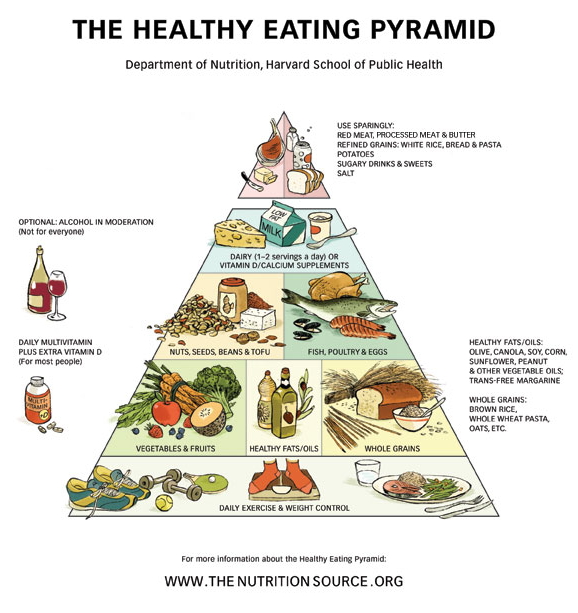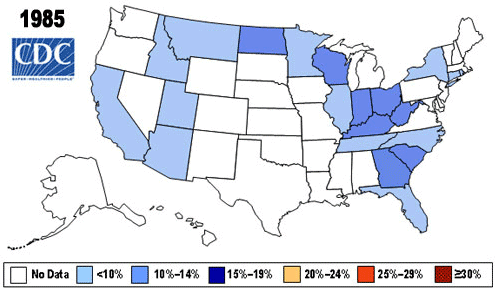
You are what you eat! The new food pyramid gives us an idea of what we should be eating. We will analyze our dietary habits in this lab to see how we compare. For one full week (7 days), record everything that you eat and drink (except water, which has no calories). Here's the simple equation that determines your weight:
Background: Remember that food is like fuel. It contains energy, which we measure in calories. When you digest your food, you break it down and release the energy found in the bonds between molecules. If you take in more fuel than you need, the excess energy is stored as fat, a lightweight (does this surprise you?) high energy storage molecule. When you need energy and none is readily available, you can break down the fat and release the energy again. Unfortunately, most of us consume more food and are less physically active than we should be, and this has led to an obesity epidemic in the developed world. The Red Cross recently announced that in 2012, more people die of obesity than of starvation. What changes in our lifestyles account for it? Most of us don't have jobs that are physically strenuous. We have all the food we want, and we have more unhealthy food choices than in the past. We drive almost everywhere we go. We spend more time in front of TVs and computers and less time outside being active. All of these factors contribute to the problem.

The obesity epidemic in America, from 1985 to 2010
For practice, look up the following foods to get a sense of how many calories are found in each item. Skip the last 2 columns for now.
| Serving Size Eaten | Total Calories Consumed | |||||||
| Example: Granola bar | 1 bar | 110 cals | 2 g. | 16 g. | 5 g. | 1 g. | 1 | 110 |
| McDonald's Big Mac | ||||||||
| Garden Salad with light (low-cal) dressing | ||||||||
| Chicken Caesar Salad with dressing | ||||||||
| 6 inch Subway turkey sandwich | ||||||||
| Single serving bag of Doritos potato chips | ||||||||
| Snickers Bar | ||||||||
| Can of regular CocaCola | ||||||||
| Iced Tea (unsweetened) | ||||||||
| Glass of red wine | ||||||||
| Bottle of beer |
Assignment: Download and install the free trial of the Diet Sleuth software for Mac or Windows, which works without registering for up to two weeks. If you like the program, you can purchase it for further use. Use Diet Sleuth to keep track of everything you eat (not just what, but how many servings) for 7 days. If you prefer not to use the program, you could instead read the labels on the packaging and record this information directly into a table like the one shown above, either on paper or in a spreadsheet.
1. Total up all of the calories you have consumed for a 7 day period, and divide by 7 for your daily average intake. Is there a pattern? At what time of day do you consume most of your calories? Is there any difference between weekdays and weekends?
2. What percentage of your total diet is fat _____% , carbohydrate _____% , protein _____%
3. Choose your activity level. (These are for adults. If you are still growing or have a high metabolism, choose a higher number.)
4. Calculate calories needed per day:
5a. One pound of fat contains 3500 calories. If you want to lose 25 pounds, for example, how many calories is that?
5b. If you want to lose one pound (3500 cals) per week, you would need to burn an extra 500 calories per day, or reduce your intake by the same amount. (3500 cals / 7 days = 500 cals/day)
5c. How much exercise do you have to do to burn 500 calories per day? Try this exercise calculator for an estimate.
6. If you want to lose all of the weight in 1 month (30 days), how many extra calories per day must be burned? Is losing this much weight in a month practical?
7. Take a look at the Recommended Daily Intake tables, and determine how your diet compares to the Daily Reference Values (DRVs) for total fat, saturated fat, cholesterol, sodium, potassium, total carbohydrate, dietary fiber, and protein.
8. What is the importance of vitamins? What's the difference between fat-soluble and water-soluble vitamins? When can fat-soluble vitamins be dangerous? Do people with good diets need vitamin supplements? What is a vitamin deficiency? Look up scurvy and rickets on Wikipedia.
| Food type | calories per gram |
| Fat | 9 cals/g |
| Protein | 4 cals/g |
| Carbohydrate | 4 cals/g |
| Alcohol | 7 cals/g |
9. 1 gram of fat yields 9 calories. 1 gram of protein yields 4 calories and 1 gram of carbohydrate yields 4 calories. If you eat 250 grams of a food which is 25% fat, 35% protein and 40% carbohydrate, calculate total calories consumed? _________
10. Refer to the weight tables for adult males and females, and the recommended caloric intake of adult males and females. How will you change your diet based on what you have learned?
A few important take away points:
1. Control what and how you eat:
2. Exercise more and you can diet less:
3. Keep your expectations realistic: